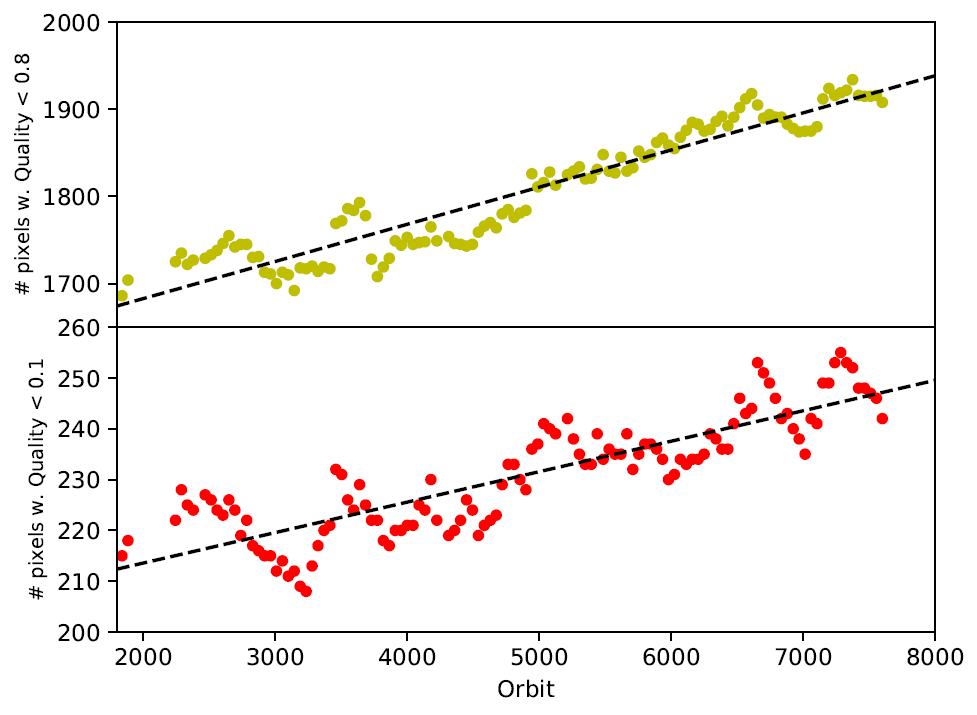Ter gelegenheid van de eerste twee volle jaren in de ruimte heeft het blad Atmospheric Measurement Techniques (AMT) een speciaal nummer uitgebracht over TROPOMI. Daarin publiceren SRON-onderzoekers de prestaties van de Short Wavelength Infrared module in het eerste jaar. Die blijken stabiel, met een klein aantal nieuwe dode pixels.

SRON is de co-Principal Investigator van TROPOMI, het enige instrument aan boord van de aardobservatiesatelliet Sentinel-5p. Het ruimteonderzoeks-instituut heeft de uitleeselektronica en de verzonken tralie ontwikkeld voor de Short Wavelength Infrared (SWIR) detector, en is wetenschappelijk verantwoordelijk voor het SWIR-kanaal. Daar hoort de analyse van de instrument prestaties bij. SRON-onderzoeker Tim van Kempen en zijn collega’s publiceren hun resultaten in Atmospheric Measurement Techniques (AMT).
Background noise
To compensate for the background noise, the SWIR detector regularly needs to perform a calibration measurement in the dark. Earth’s nightside turns out to be too bright for that, partially because of forest fires and oil fields. ‘That’s why we decided together with KNMI to close the instrument while conducting the measurements,’ says Van Kempen. ‘There is only a warranty on a limited number of movements, so we do this for every third orbit instead of each passageway across the nightside.’
‘In order to know what we need to correct for when looking at reflected sunlight, we perform a calibration for the Sun. We do that when the satellite flies above the North Pole.’
Orbit corrections
Aside from analyzing the performance, it is also important to check if the SWIR module responds correctly to changes in its orbit or other incidents. Every year in the fall, Sentinel-5p performs a correction on its orbit, during which the detector is briefly exposed to direct sunlight. This affects the quality of the data for a few orbits. It is SRON’s job to monitor the recovery.
The satellite has dodged space debris a few times. At one instance all four engines switched on by accident. This caused the instruments to get too hot for proper measurements. The SWIR module quickly recovered from this.
Apart from these incidents, the SWIR module has performed very stable. This is partially thanks to the fact that the loss of pixels is negligible. There are a quarter million pixels, of which a few thousand are defect; since the launch only a few hundred extra pixels have joined them.

TROPOMI’s first year: stable performance SWIR detector
On the occasion of the first two full years in space, the journal Atmospheric Measurement Techniques (AMT) has released a special issue about TROPOMI. In it, SRON researchers publish a paper on the performance of the Short Wavelength Infrared module in the first year. The module appears to be stable, with a small number of new dead pixels.
SRON is the co-Principal Investigator of TROPOMI, the only instrument onboard earth observation satellite Sentinel-5p. The space research institute has developed the read-out electronics and the immersed grating for the Short Wavelength Infrared (SWIR) detector, and is scientifically responsible for the SWIR channel. Analysis of the instrument performance is part of this. SRON researcher Tim van Kempen and his colleagues publish their results in Atmospheric Measurement Techniques (AMT).
Background noise
To compensate for the background noise, the SWIR detector regularly needs to perform a calibration measurement in the dark. Earth’s nightside turns out to be too bright for that, partially because of forest fires and oil fields. ‘That’s why we decided together with KNMI to close the instrument while conducting the measurements,’ says Van Kempen. ‘There is only a warranty on a limited number of movements, so we do this for every third orbit instead of each passageway across the nightside.’
‘In order to know what we need to correct for when looking at reflected sunlight, we perform a calibration for the Sun. We do that when the satellite flies above the North Pole.’
Orbit corrections
Aside from analyzing the performance, it is also important to check if the SWIR module responds correctly to changes in its orbit or other incidents. Every year in the fall, Sentinel-5p performs a correction on its orbit, during which the detector is briefly exposed to direct sunlight. This affects the quality of the data for a few orbits. It is SRON’s job to monitor the recovery.
The satellite has dodged space debris a few times. At one instance all four engines switched on by accident. This caused the instruments to get too hot for proper measurements. The SWIR module quickly recovered from this.
Apart from these incidents, the SWIR module has performed very stable. This is partially thanks to the fact that the loss of pixels is negligible. There are a quarter million pixels, of which a few thousand are defect; since the launch only a few hundred extra pixels have joined them.



